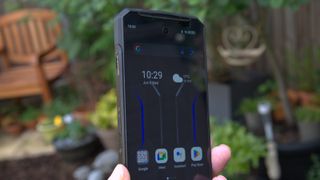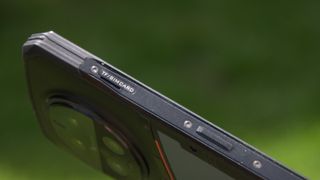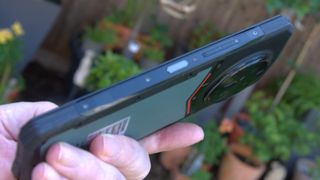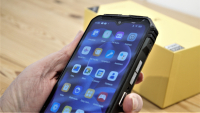TechRadar Verdict
A great value design that combines performance and resilience but at an affordable price. Battery life isn’t huge, but it should get most people through two working days. But the rest of the feature set is excellent, especially the cameras.
Pros
- +
Relatively lightweight
- +
Impressive camera selection
- +
512GB of storage
- +
WiFi6 and 5G
Cons
- -
Limited battery life
- -
No audio jack
- -
Lacks Widevine L3 encryption
Why you can trust TechRadar
30-second review
Doogee makes some gargantuan rugged phones so heavy that you might decline the opportunity to carry them into the wilderness on a hike.
The new DK10 or ‘Duke’ attempts to address those issues with a rugged design that won’t require you to hire a sherpa to carry it and yet has all the rugged features that adventurers and outdoor workers can appreciate.
With an asking price of more than $500 from Doogee, the DK10 is positioned to be cheaper than a premium phone but a notch up from the best rugged phones on a budget.
For this much money, you expect better specifications, and the DK10 doesn’t disappoint. It has a new MediaTek Dimensity 8020 processor, 12GB of RAM, and 512GB of storage.
It also features an intensively colourful 6.67-inch AMOLED 2.5K “Blind Hole” display that produces smooth 120Hz output. The feature set includes WiFi 6 and 5G comms, with four rear-mounted cameras. Even the selfie sensor is 50MP for those who want to look their best.
The price isn’t crazy, and the specifications are excellent, so what’s the catch with the DK10?
There are a few minor annoyances. Doogee didn’t provide an audio jack or an adapter to get that from the USB port, and the camera cluster sticks out so much that it impedes wireless charging. However, it is supplied with a 100W charger that can quickly replenish the battery and supports 50W wireless charging.
These are good features, but the balance here is that the battery in the DK10 is only 5150mAh, which is relatively small by rugged phone standards.
Overall, Doogee sacrificed the DK10's battery capacity to make it more portable, which may or may not fit your needs.

Doogee DK10: price and availability
- How much does it cost? From $520/£410
- When is it out? Now
- Where can you get it? Direct from Doogee or through an online retailer
Direct from Doogee, the DK10 costs $519/£405.16, but a promotion currently knocks $50 off that, reducing the cost to $469.99 in the USA. The only slight snag is that Doogee is short of stock and is promising to re-stock soon.
While the phone can be bought directly from Amazon.com, however, the asking price is $529.99, a 16% reduction on the $629.99 MSRP.
Some other online retailers, like Newegg, are offering the DK10 for a little less than Amazon, but the phone ships from Hong Kong, not from the USA.
If you are willing to wait for delivery from Asia, AliExpress has the phone for only $375.99 with free shipping, a 30% reduction on the quoted standard price of $537.13. It appears to be the cheapest option, though you might have to wait 20 or more days for the phone to arrive.
Depending on where and how you buy the DK10, it fluctuates between reasonably good value or an absolute bargain, considering the specifications and price options.

- Value score: 4/5
Doogee DK10:Specs
| CPU: | MedtiaTek Dimensity 8020 |
| GPU: | ARM Mali-G77 MC9 GPU |
| RAM: | 12GB LPDDR4X |
| Storage: | 512GB uMCP |
| Screen(s): | 6.67-inch AMOLED 2.5K Blind Hole Display 120Hz |
| Resolution: | 2400 x 1080 |
| SIM: | 1x Nano SIM, 1x Nano SIM or MicroSD card |
| Weight: | 305g |
| Dimensions: | 181.7 x 83.1 x 12.7 mm |
| Rugged Spec: | IP68, MIL-STD-810H compliant |
| Rear camera: | Morpho Quad Camera (50MP+50MP+64MP+16MP) |
| Front camera: | 50MP |
| Networking: | WiFi 6, Bluetooth 5.3 |
| OS: | Android 13 |
| Battery: | 5150mAh (Max charge 120W, Wireless 50W) |
| Colours: | Emerald Green, Kevlar Black |
Doogee DK10: design
- Retro styled
- Common button layout
- Large camera cluster
The DK10's styling is slightly retro in that it embraces a visible bolt head motif that was popular previously. We’re unsure if the bolts are real and can be unscrewed, but they are recessed on the back and sides, and we counted 21.
What is more pleasing is that the back of the DK10 has an embedded material, Emerald Green, on our review device that has a cushioned feel and a subtle texture that makes it easy to handle. Or rather, it would be if Doogee hadn’t stuck a massive metallic sticker on it with twenty barcodes emblazoned on it.
The button layout is strictly by-the-numbers, with the power button/fingerprint reader on the right along with the volume rocker and a user-customisable button on the left adjacent to the SIM tray.
The SIM tray is one of those where you get to choose if having two Nano SIMs or one and a Micro SD card is more important. However, with the internal storage being 512GB, using two SIMs is less of a compromise than it might be elsewhere.

One aspect of this design that is less welcome is the size and projection of the camera cluster, as it’s a 55mm wide disc that stands at least 3.5 mm proud of the surface.
It may be that for the optics of the cameras, this profile is a necessity, but it doesn’t help make the phone sit flat if you are trying to wirelessly charge it.
However, the sensor cluster is at least central, bringing the majority of the sensors closer to the centerline of the phone for easier photography.
It does have a rubber plug over the USB port, which is annoying if you need to charge it every day. Removing it will make the phone less water—and dust-resistant, but thankfully, it can wirelessly charge.
Overall, the DK10 is not a showstopper from a design viewpoint, as it follows the general consensus of what an Android phone is these days.

Design score: 4/5
Doogee DK10: hardware
- MedtiaTek Dimensity 8020
- WiFi 6 and G5
- AMOLED screen
The two phones that this reminds us of most are the Nokia XR21 and Samsung XCover 7, as these also went with smaller batteries to enhance the device's portability.
However, these used relatively low-specification processors, whereas the DK10 comes out with all guns blazing using the MediaTek Dimensity 8020.
The Dimensity 8020 SoC is part of a new generation of Dimensity SoCs, which can also be seen in the Ulefone Armor 26. It sports four ARM Cortex-A78 performance cores and four ARM Cortex-A55 efficiency cores. The performance cores can clock to 2.6GHz, whereas the efficiency chiplets are capped at 2GHz.
This platform is more interesting for gamers because it comes with the nine-core ARM Mali-G77 GPU, a significant enhancement over older Dimensity options.
This phone has plenty of power, and it can play MiraVision HDR10+ video files and AV1 content decoding through hardware. However, as with many Chinese phone designs, Doogee failed to license this device for Widevine L1 video encryption, so most of the popular paid streaming services will be limited to 480p resolution under Widevine L3.
What makes that a genuine shame in this context is that the 6.67-inch AMOLED display with 120Hz refresh is ideal for video playback, and using YouTube HDR examples as a source makes it look spectacular. Why Doogee didn’t give the DK10 Widevine L1 is curious since it might have made the user experience on Disney+ or Netflix that much sweeter.
Contrary to that, the SoC also includes WiFi6 and 5G comms, with a peak download capability of 4.7Gbps and uploads of 2.5Gbps. That makes it ideal for anyone capturing 4K video that needs to secure it to the Internet quickly.
If this chip has any weaknesses, it was designed to use DDR4 memory, not the enhanced bandwidth offered by DDR5 modules.
But it's worth considering that this is a phone, not a desktop computer, and we tailor our expectations accordingly.

- Hardware score: 4/5
Doogee DK10: cameras
- 50MP Main sensor
- 50MP selfie
- 4K video and 64MP night vision

The Doogee DK10 has five cameras:
- Rear cameras: Morpho Quad Camera (50MP+50MP+64MP+16MP)
Front camera: 50MP
It’s tempting to look at the camera spec of the DK10 and wonder why it got a 50MP main sensor when others in the Doogee range got 108MP, like the Doogee S100 Pro.
But that ignores how good the sensors on this phone are and that on the rear alone, it has four sensors for image and video capture branded as Morpho Quad.
The primary sensor is the Samsung S5KGN1, which is 50MP and uses pixel binning for better colour representation and image fidelity. Alongside that is another 50MP sensor for ultra-wide and macro work, a 64MP night vision sensor, and finally, a 16MP long focus camera that has a 4x optical zoom, along with 30x digital scaling.
Other phones have gone with maybe two or three sensors and repurposed the primary sensor for different things, but here, Doogee tried to make each mode the best it could be.
The results are generally excellent, with rich saturated colours on the Samsung S5KGN1 and exceptionally sharp night vision output.
Video capture is 4K, although there is no control over FPS other than using the dedicated slow-motion mode.
One slight oddity is that the front-facing selfie camera is also 50MP, though with a sensor that big, it can only take 1080p video.
Rather than leaning on one big sensor to carry the photographic ability of the phone, Doogee went with a horses-for-courses approach that offers a wider range of uses and good-quality captures. Using the example image results, they support the view that this approach might be a better way.
Doogee DK10 Camera samples













- Camera score: 3.5/5
Doogee DK10: performance
- Powerhouse SoC
- Gaming graphics
- Poor battery life
| Benchmark | Test | Doogee DK10 | Samsung Galaxy XCover 7 | Motorola ThinkPhone |
|---|---|---|---|---|
| Soc | Row 0 - Cell 1 | Dimensity 8020 | Dimensity 6100+ | Snapdragon 8+ Gen 1 |
| Battery mAh | Row 1 - Cell 1 | 5150 | 4050 | 5000 |
| Geekbench: | Single-core | 756 | 530 | 1314 |
| Row 3 - Cell 0 | Multi-core | 2904 | 1707 | 4259 |
| Row 4 - Cell 0 | OpenCL | 4598 | 1471 | 6357 |
| GFX | Aztec OpenGL Norm fps | 46 | 13 | 117 |
| Row 6 - Cell 0 | Aztec Vulkan Norm fps | 40 | 12 | 126 |
| Row 7 - Cell 0 | Car Chase fps | 39 | 12 | 85 |
| Row 8 - Cell 0 | Manhattan 3.1 fps | 72 | 22 | 120 |
| PCMark: | Score | 14208 | 7939 | 16474 |
| Row 10 - Cell 0 | Battery | 8h 34m | 17h 19m | 15h 25m |
| Row 11 - Cell 0 | % gained in 30m charge | 33 | 28 | 55 |
| Passmark: | Overall Score | 14669 | 9364 | 16525 |
| Row 13 - Cell 0 | CPU Score | 7119 | 4607 | 8080 |
| 3DMark: | Slingshot OpenGL | 8571 | 3376 | Maxed Out |
| Row 15 - Cell 0 | Slingshot Extr. Open GL | Maxed | 2384 | Maxed Out |
| Row 16 - Cell 0 | Slingshot Extr. Vulkan | Maxed | 2353 | Maxed Out |
| Row 17 - Cell 0 | Wild Life | 4275 | 1225 | N/A |
The two phones we’ve covered here on TechRadar Pro that are nearest in terms of what they offer are the Samsung Galaxy XCover 7 and Motorola Thinkphone. Those two and the DK10 all offer a lightweight, rugged design with a limited battery capacity.
From our initial benchmarks, it was obvious that the DK10 has substantially more power than the XCover 7, though not at the level that the Qualcomm-powered Thinkphone can muster.
To access the Dimensity 8020, it's best to consider it comparable to the Snapdragon 7 Gen 1 rather than the top Qualcomm SoCs.
Looking at the graphics tests in general, the Dimensity 8020 has three times the GPU power of the Dimensity 6100+ and about half of what the Snapdragon 8+ Gen 1 can field. That’s a highly respectable performance, and most gamers would enjoy this device.
Things go slightly wrong in battery testing, where with the largest battery, the machine's lifespan running the PCMark battery test was the worst.
Based on these results, the DK10 might get you through a working day, but there won’t be much left the next morning. That might be a disaster if you fail to plug it in for an overnight charge, but using the 100W PSU, we get 33% of the capacity back within 30 minutes of charging. Charging at that speed should enable the phone to be fully charged within 90 minutes or less.
It might be possible to extend battery life by turning off services and lowering screen brightness. But for those wanting to take this phone hiking and unlikely to receive an SMS message, call or find a WiFi shack, it would probably be prudent to switch it off when not in use.
The DK10's battery life is one downside to its performance, but the rest of this device works very neatly and provides an excellent user experience.
- Performance score: 3.5/5

Doogee DK10: Verdict
While the styling of this device is not to everyone’s taste, the package of performance SoC, a high-quality display and lots of memory and storage makes for a compelling device. It’s one of the few rugged designs that might work as a daily driver since it's not much larger or heavier than an ordinary phone.
The only caveats are the battery capacity and life, which aren’t ideal if you intend to leave civilisation for any period. And the extent to which the camera cluster sticks out is annoying.
Those points aside, and accepting that most Chinese phones ignore Widevine video encryption requirements, the DK10 is an elegant piece of hardware that could be ideal for those who work outdoors.
Should I buy a Doogee DK10?
| Attributes | Notes | Rating |
|---|---|---|
| Value | This much phone for less than $500 is a bargain | 4/5 |
| Design | Oddly retro but nice to hold and easy to use | 4/5 |
| Hardware | A powerhouse SoC that gamers will like and both WiFi 6 and 5G capable. | 4/5 |
| Camera | Five sensors covering wide angle, macro and night vision | 4/5 |
| Performance | Fast and powerful, but the SoC drains the battery too quickly | 3.5/5 |
| Overall | An impressive phone only held back by battery capacity | 4/5 |
Buy it if...
You need a phone for outdoors
The water and dust resistance on the DK10 is enough for working outside even in the rain and it can cope with being dropped.
You like lots of photo options
There are many photo modes with the four rear sensors that should include whatever type of photography you intend to do.
Don't buy it if...
You like long adventure holidays
The weakness of the DK10 is the battery capacity which isn't ideal without regular connection to mains power via the 100W charger.
Also consider
Doogee S100 Pro
Using the G99 SoC and 104MP camera sensor, this is a previous Doogee design and a cheaper alternative. You get a huge 22000mAh battery for the investment, making it last longer on battery power but also much heavier to carry.
Read our Doogee S100 Pro review for more information.
Lenovo ThinkPhone by Motorola
Lenovo sold another lightweight, rugged design outside the USA. It’s more expensive than the DK10, but it uses the superior Snapdragon 8+ Gen 1 SoC, and it has better battery life.
Read our Lenovo ThinkPhone by Motorola review for more information.
If this device isn’t for you, check out our best Rugged Phones collection.
Mark is an expert on 3D printers, drones and phones. He also covers storage, including SSDs, NAS drives and portable hard drives. He started writing in 1986 and has contributed to MicroMart, PC Format, 3D World, among others.

This dangerous new Linux malware is going after VMware systems with multiple extortion attempts

Temu, Shein and Aliexpress are attracting US customers in their millions, poll shows — and that's despite the fact the vast majority do not trust these online Chinese retailers in the first place

iPhone SE 4 tipped to be a controversial but powerful upgrade that lands in early 2025


